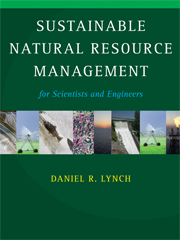6 - POLLUTION
Published online by Cambridge University Press: 31 January 2011
Summary
Contamination affects all natural resources. Our basic classification scheme uses two binary axes, and each of the four quadrants is illustrated in previous chapters without reference to contamination. But essentially, there is a third binary axis, perhaps “degradability.” Simpson et al. in revisiting the classic Barnett/Morse examination of finite resources, referred to the “‘New Scarcity’ – the limitations on the environment's capacity to absorb and neutralize.”
The general field of pollution is huge. Here we introduce some basic analyses, for further consideration.
The context: Waste material is loaded into a receiving medium. The material is assumed to be dangerous when aggregated. It will be accumulated, removed, transformed, and/or sequestered, but accumulation alone is not sustainable. An acceptable balance with at least one other rate is necessary if sustained loading is to occur.
The medium itself is a “resource in reverse.” Separate loadings have cumulative effects on the common receiving medium. Its assimilative capacity is the rate at which aggregate loading can be received and processed with acceptable accumulation. A sustainable balance between loading and accumulation relies on the other rates mentioned: removal, transformation, sequestration. Managing these rates, and the collective loading they balance, is the resource management challenge.
BASIC PROCESSES
The basic system is illustrated in Figure 6.1. The variables are
M: the mass of material
L: the loading rate, mass/time
R: the removal rate, mass/time
V: the volume of the receiving medium
Qi: the volumetric flow rate of fluid entering the system, volume/time
Q: the volumetric flow rate of fluid leaving the system, volume/time
- Type
- Chapter
- Information
- Sustainable Natural Resource ManagementFor Scientists and Engineers, pp. 188 - 215Publisher: Cambridge University PressPrint publication year: 2009



